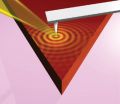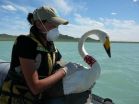(Press-News.org) Breast cancer patients with high levels of vitamin D in their blood are twice as likely to survive the disease as women with low levels of this nutrient, report University of California, San Diego School of Medicine researchers in the March issue of Anticancer Research.
In previous studies, Cedric F. Garland, DrPH, professor in the Department of Family and Preventive Medicine, showed that low vitamin D levels were linked to a high risk of premenopausal breast cancer. That finding, he said, prompted him to question the relationship between 25-hydroxyvitamin D — a metabolite produced by the body from the ingestion of vitamin D — and breast cancer survival rates.
Garland and colleagues performed a statistical analysis of five studies of 25-hydroxyvitamin D obtained at the time of patient diagnosis and their follow-up for an average of nine years. Combined, the studies included 4,443 breast cancer patients.
"Vitamin D metabolites increase communication between cells by switching on a protein that blocks aggressive cell division," said Garland. "As long as vitamin D receptors are present tumor growth is prevented and kept from expanding its blood supply. Vitamin D receptors are not lost until a tumor is very advanced. This is the reason for better survival in patients whose vitamin D blood levels are high."
Women in the high serum group had an average level of 30 nanograms per milliliter (ng/ml) of 25-hydroxyvitamin D in their blood. The low group averaged 17 ng/ml. The average level in patients with breast cancer in the United States is 17 ng/ml.
"The study has implications for including vitamin D as an adjuvant to conventional breast cancer therapy," said co-author Heather Hofflich, DO, UC San Diego associate professor in the Department of Medicine.
Garland recommended randomized controlled clinical trials to confirm the findings but suggested physicians consider adding vitamin D into a breast cancer patient's standard care now and then closely monitor the patient.
"There is no compelling reason to wait for further studies to incorporate vitamin D supplements into standard care regimens since a safe dose of vitamin D needed to achieve high serum levels above 30 nanograms per milliliter has already been established," said Garland.
A 2011 meta-analysis by Garland and colleagues estimated that a serum level of 50 ng/ml is associated with 50 percent lower risk of breast cancer. While there are some variations in absorption, those who consume 4,000 International Units (IU) per day of vitamin D from food or a supplement normally would reach a serum level of 50 ng/ml. Garland urged patients to ask their health care provider to measure their levels before substantially increasing vitamin D intake.
According to the National Institutes of Health, the current recommended daily allowance for vitamin D is 600 IU for adults and 800 IU for people over 70 years old.
INFORMATION:Additional contributors to the study include first author Sharif B. Mohr and June Kim, Science Applications International Corporation; and Edward D. Gorham, UCSD Department of Family and Preventive Medicine.
Funding for the study was provided, in part, by a Congressional allocation to the Penn State Cancer Institute of the Milton S. Hershey Medical Center, Hershey, PA, through a cooperative research agreement.
Vitamin D increases breast cancer patient survival
2014-03-06
ELSE PRESS RELEASES FROM THIS DATE:
UT Arlington study links BPA and breast cancer tumor growth
2014-03-06
UT Arlington biochemists say their newly published study brings researchers a step closer to understanding how the commonly used synthetic compound bisphenol-A, or BPA, may promote breast cancer growth.
Subhrangsu Mandal, associate professor of chemistry/biochemistry, and Arunoday Bhan, a PhD student in Mandal's lab, looked at a molecule called RNA HOTAIR. HOTAIR is an abbreviation for long, non-coding RNA, a part of DNA in humans and other vertebrates. HOTAIR does not produce a protein on its own but, when it is being expressed or functioning, it can suppress genes that ...
NASA's TRMM satellite images show California soaker moved eastward
2014-03-06
The Tropical Rainfall Measuring Mission or TRMM satellite provided a look at the rainfall associated with the large storm system that brought soaking rains to California on Feb. 28 and Mar. 1. Satellite imagery created at NASA shows the movement of the storm from the U.S. West Coast to the East Coast.
At NASA's Goddard Space Flight Center in Greenbelt, Md. images were created using data from the TRMM Microwave Imager (TMI) instrument that showed the movement of recent stormy weather from California's Pacific Ocean coast to the Atlantic Coast. TRMM is a satellite managed ...
NASA's THEMIS discovers new process that protects Earth from space weather
2014-03-06
In the giant system that connects Earth to the sun, one key event happens over and over: solar material streams toward Earth and the giant magnetic bubble around Earth, the magnetosphere helps keep it at bay. The parameters, however, change: The particles streaming in could be from the constant solar wind, or perhaps from a giant cloud erupting off the sun called a coronal mass ejection, or CME. Sometimes the configuration is such that the magnetosphere blocks almost all the material, other times the connection is long and strong, allowing much material in. Understanding ...
Crystals ripple in response to light
2014-03-06
Light can trigger coordinated, wavelike motions of atoms in atom-thin layers of crystal, scientists have shown. The waves, called phonon polaritons, are far shorter than light waves and can be "tuned" to particular frequencies and amplitudes by varying the number of layers of crystal, they report in the early online edition of Science March 7.
These properties - observed in this class of material for the first time - open the possibility of using polaritons to convey information in tight spaces, create images at far finer resolution than is possible with light, and manage ...
Plasma plumes help shield Earth from damaging solar storms
2014-03-06
The Earth's magnetic field, or magnetosphere, stretches from the planet's core out into space, where it meets the solar wind, a stream of charged particles emitted by the sun. For the most part, the magnetosphere acts as a shield to protect the Earth from this high-energy solar activity.
But when this field comes into contact with the sun's magnetic field — a process called "magnetic reconnection" — powerful electrical currents from the sun can stream into Earth's atmosphere, whipping up geomagnetic storms and space weather phenomena that can affect high-altitude aircraft, ...
Researchers calculate how river networks move across a landscape
2014-03-06
Large river networks — such as those that funnel into the Colorado and Mississippi rivers — may seem to be permanent features of a landscape. In fact, many rivers define political boundaries that have been in place for centuries.
But scientists have long suspected that river networks are not as static as they may appear, and have gathered geologic and biological evidence that suggest many rivers have been "rewired," shifting and moving across a landscape over millions of years.
Now researchers at MIT and the Swiss Federal Institute of Technology (ETH Zurich) have developed ...
Warmer temperatures push malaria to higher elevations
2014-03-06
Researchers have debated for more than two decades the likely impacts, if any, of global warming on the worldwide incidence of malaria, a mosquito-borne disease that infects more than 300 million people each year.
Now, researchers from the London School of Hygiene & Tropical Medicine and the University of Michigan, with colleagues, are reporting the first hard evidence that malaria does—as had long been predicted—creep to higher elevations during warmer years and back down to lower altitudes when temperatures cool.
The study, due to be published in Science and based ...
Scientists create detailed picture of protein linked to learning, pain and brain disorders
2014-03-06
LA JOLLA, CA, and NASHVILLE, TN – March 6, 2014 – Researchers at The Scripps Research Institute (TSRI) and Vanderbilt University have created the most detailed 3-D picture yet of a membrane protein that is linked to learning, memory, anxiety, pain and brain disorders such as schizophrenia, Parkinson's, Alzheimer's and autism.
"This receptor family is an exciting new target for future medicines for treatment of brain disorders," said P. Jeffrey Conn, PhD, Lee E. Limbird Professor of Pharmacology and director of the Vanderbilt Center for Neuroscience Drug Discovery, who ...
Warmer temperatures fuel spread of malaria into higher elevations
2014-03-06
In the tropical highlands of South America and East Africa, cool temperatures have historically kept mosquito-borne diseases, such as malaria, at bay. New research by Howard Hughes Medical Institute (HHMI) scientists shows that as annual temperatures rise in these areas, malaria can spread to populations in higher elevations that had historically not been at as much risk of being infected by malaria parasites.
HHMI scientists have compared the yearly distribution of malaria cases in two mountainous regions in South America and East Africa, and found that in warmer years, ...
Birds of all feathers and global flu diversity
2014-03-06
A group of international scientists have completed the first global inventory of flu strains in birds by reviewing more than 50 published studies and genetic data, providing new insight into the drivers of viral diversity and the emergence of disease that can ultimately impact human health and livelihoods.
The research, published in the journal PLOS ONE and performed as part of the USAID PREDICT project, identified over 116 avian flu strains in wild birds. This is roughly twice the number that were found in domestic birds, and more than ten times the number found in humans. ...





